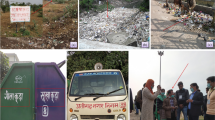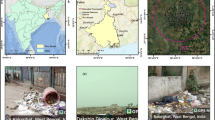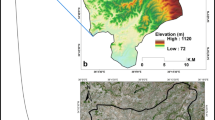Abstract
Municipal solid waste is typically managed in developing countries through various disposal methods, such as sanitary landfills or dumpsites. Alternatively, waste to energy (WTE) systems have been recently adopted to provide sustainable waste management and diversify the energy mix. The abundance of remotely sensed datasets and derivatives, along with the rapid development of artificial intelligence, can offer an effective solution for WTE site selection. In this study, an analytical hierarchy process (AHP)-based framework supported by multiple machine learning algorithms (gradient boosted tree (GBT), decision tree (DT), and support vector machines (SVMs)) was established to explore the optimum location for WTE facilities. Various social, legal, environmental, economic, morphological, and land cover parameters were considered under 11 thematic geospatial raster layers. The proposed framework was applied to the 1.5-million-capita city of Sharjah, United Arab Emirates. A novel approach was developed to incorporate Gaussian dispersion modeling for the expected air pollution emissions from a WTE facility. The results showed that the accuracy performance sequence of the algorithms was 94.6, 93.9, and 91.8% for GBT, DT, and SVM, respectively. It was found that the distance from existing landfills had the most critical impact on the optimum location of the WTE facility, followed by the distance from coastline and elevation. The AHP consistency check revealed an acceptable overall criteria consistency index and the ratio of 0.0344 and 0.019, respectively. The results showed that 16.6% of Sharjah was considered extremely highly suitable areas. This research supports decision-makers in developing local guidelines for siting WTE facilities and determining the most suitable locations for such projects.








Similar content being viewed by others
References
Abdallah M, Shanableh A, Shabib A, Adghim M (2018) Financial feasibility of waste to energy strategies in the United Arab Emirates. Waste Manag 82:207–219. https://doi.org/10.1016/j.wasman.2018.10.029
Abdallah M, Shanableh A, Arab M et al (2019) Waste to energy potential in middle income countries of MENA region based on multi-scenario analysis for Kafr El-Sheikh Governorate, Egypt. J Environ Manag 232:58–65. https://doi.org/10.1016/j.jenvman.2018.11.029
Abdallah M, Arab M, Shabib A et al (2020) Characterization and sustainable management strategies of municipal solid waste in Egypt. Clean Techn Environ Policy 22:1371–1383. https://doi.org/10.1007/s10098-020-01877-0
Abdulhasan MJ, Hanafiah MM, Satchet MS et al (2019) Combining gis, fuzzy logic, and ahp models for solid waste disposal site selection in Nasiriyah, Iraq. Appl Ecol Environ Res 17:6701–6722. https://doi.org/10.15666/aeer/1703_67016722
Aboziah RA (2017) Landfill site selection for solid waste disposal using geographical information system (GIS) and multi-criteria approach in the Tarkwa Nsuaem Municipality, Ghana. oai:http://ir.knust.edu.gh:123456789/10128
Ahmadi M, Teymouri P, Dinarvand F et al (2014) Municipal solid waste landfill site selection using analytical hierarchy process method and geographic information system in Abadan, Iran. Iran J Heal Sci 2:37–50. https://doi.org/10.18869/acadpub.jhs.2.1.37
Alavi N, Goudarzi G, Babaei AA et al (2013) Municipal solid waste landfill site selection with geographic information systems and analytical hierarchy process: a case study in Mahshahr County, Iran. Waste Manag Res 31:98–105. https://doi.org/10.1177/0734242X12456092
Ali SA, Ahmad A (2020) Suitability analysis for municipal landfill site selection using fuzzy analytic hierarchy process and geospatial technique. Environ Earth Sci 79:1–27. https://doi.org/10.1007/s12665-020-08970-z
Al-Ruzouq R, Shanableh A, Omar M, Ghadeer A-K (2018) Macro and micro geo-spatial environment consideration for landfill site selection in Sharjah, United Arab Emirates. Environ Monit Assess 190:147. https://doi.org/10.1007/s10661-018-6538-1
Alzate-Arias S, Jaramillo-Duque Á, Villada F, Restrepo-Cuestas B (2018) Assessment of government incentives for energy from waste in Colombia. Sustainability 10:1294. https://doi.org/10.3390/su10041294
Anifowose YB, Omole KE, Akingbade OO (2012) Waste disposal site selection using remote sensing and GIS : a study of Akure and its environs, Southwest-Nigeria. Coler Proc 2:526–533. https://doi.org/10.13140/2.1.4890.1122
Aziz RS, Khodakarami L (2013) Application of GIS models in site selection of waste disposal in an urban area. WIT Trans State-of-the-art Sci Eng 77:27–35. https://doi.org/10.2495/ISUD130041
Beskese A, Demir HH, Ozcan HK, Okten HE (2015) Landfill site selection using fuzzy AHP and fuzzy TOPSIS : a case study for Istanbul. Environ Earth Sci 73:3513–3521. https://doi.org/10.1007/s12665-014-3635-5
Chan J, Chan K, Yeh A (2001) Detecting the nature of change in an urban environment: a comparison of machine learning algorithms. Photogramm Eng Remote Sens 67:213–225 0099-1112/01/6702-213$3.00
Chauhan R, Kaur H (2016) Predictive analytics and data mining: a framework for optimizing decisions with R tool. Bus Intell Concepts, Methodol Tools, Appl IGI Global:359–374. https://doi.org/10.4018/978-1-4666-4940-8.ch004
Childs C (2004) Interpolating surfaces in ArcGIS Spatial Analyst. ArcUser 3235:32–35. https://doi.org/10.1007/978-0-387-35973-1_369
De Nevers N (2000) Air Pollution Control Engineering, 2nd edn. McGraw Hill Companies International Edition, New York (In English)
Ekmekçioğlu M, Kaya T, Kahraman C (2010) Fuzzy multicriteria disposal method and site selection for municipal solid waste. Waste Manag 30:1729–1736. https://doi.org/10.1016/j.wasman.2010.02.031
FEA-UAE (2006) The regulation concerning the protection of air from pollution. Federal Environment Agency, Abu Dhabi
Fernández-González JM, Grindlay AL, Serrano-Bernardo F et al (2017) Economic and environmental review of waste-to-energy systems for municipal solid waste management in medium and small municipalities. Waste Manag 67:360–374. https://doi.org/10.1016/j.wasman.2017.05.003
Guendehou GS, Koch M, Hockstad L, Pipatti R, Yamada M (2006) Incineration and open burning of waste. In: 2006 IPCC Guidelines for National Greenhouse Gas Inventories (Vol. 5). Institute for Global Environmental Strategies (IGES), pp 1–26
Hadidi LA, Omer MM (2017) A financial feasibility model of gasification and anaerobic digestion waste-to-energy (WTE) plants in Saudi Arabia. Waste Manag 59:90–101. https://doi.org/10.1016/j.wasman.2016.09.030
Hassaan MA (2015) A GIS-based suitability analysis for siting a solid waste incineration power plant in an urban area case study : Alexandria governorate, Egypt. J Geogr Inf Syst 7:643. https://doi.org/10.4236/jgis.2015.76052
Isalou AA, Zamani V, Shahmoradi B, Alizadeh H (2013) Landfill site selection using integrated fuzzy logic and analytic network process (F-ANP). Environ Earth Sci 68:1745–1755. https://doi.org/10.1007/s12665-012-1865-y
Jamshidi A, Jahandizi EK, Moshtaghie M et al (2015) Landfill site selection: a basis toward achieving sustainable waste management. Pol J Environ Stud 24. https://doi.org/10.15244/pjoes/28641
Karkazi A, Hatzichristos T, Mavropoulos A et al (2001) Landfill siting using GIS and fuzzy logic. Proc 8th Int Waste Manag Landfill Symp. https://doi.org/10.1501/Cogbil_0000000075
Kavzoglu T, Sahin EK, Colkesen I (2014) Landslide susceptibility mapping using GIS-based multi-criteria decision analysis, support vector machines, and logistic regression. Landslides 11:425–439. https://doi.org/10.1007/s10346-013-0391-7
Khorram A, Yousefi M, Alavi SA, Farsi J (2015) Convenient landfill site selection by using fuzzy logic and geographic information systems: a case study in Bardaskan, East of Iran. Heal Scope 4. https://doi.org/10.17795/jhealthscope-19383
Leme MMV, Rocha MH, Lora EES et al (2014) Techno-economic analysis and environmental impact assessment of energy recovery from Municipal Solid Waste (MSW) in Brazil. Resour Conserv Recycl 87:8–20. https://doi.org/10.1016/j.resconrec.2014.03.003
Li X, Gar A, Yeh O (2005) Integration of genetic algorithms and GIS for optimal location search. Int J Geogr Inf Sci 19:581–601. https://doi.org/10.1080/13658810500032388
Li S, Wang Y, Hao M et al (2020) Site selection of digital signage in Beijing: a combination of machine learning and an empirical approach. ISPRS Int J Geo-Inform 9:217. https://doi.org/10.3390/ijgi9040217
Mahini AS, Gholamalifard M (2006) Siting MSW landfills with a weighted linear combination methodology in a GIS environment. Int J Environ Sci Technol 3:435–445. https://doi.org/10.1007/BF03325953
Mohammed HI, Majid Z, Yusof NB, Yamusa YB (2018) Analysis of multi-criteria evaluation method of landfill site selection for municipal solid waste management. E3S Web Conf 34:1–9. https://doi.org/10.1051/e3sconf/20183402010
Naghibi SA, Pourghasemi HR (2016) GIS-based groundwater potential mapping using boosted regression tree , classification and regression tree, and random forest machine learning models in Iran. Environ Monit Assess 188:44. https://doi.org/10.1007/s10661-015-5049-6
Ogunjuyigbe ASO, Ayodele TR, Alao MA (2017) Electricity generation from municipal solid waste in some selected cities of Nigeria: an assessment of feasibility, potential and technologies. Renew Sust Energ Rev 80:149–162. https://doi.org/10.1016/j.rser.2017.05.177
Panepinto D, Zanetti MC (2018) Municipal solid waste incineration plant: a multi-step approach to the evaluation of an energy-recovery configuration. Waste Manag 73:332–341. https://doi.org/10.1016/j.wasman.2017.07.036
Poorna A, Nehru J, Botanic T (2016) Solid waste disposal site selection by data analysis using GIS and remote sensing tools : a case study in Thiruvananthapuram corporation area. Int J Geomatics Geosci 6(1734–1747):0976–4380
Psomopoulos CS, Bourka A, Themelis NJ (2009) Waste-to-energy : a review of the status and benefits in USA. Waste Manag 29:1718–1724. https://doi.org/10.1016/j.wasman.2008.11.020
Reich MC (2005) Economic assessment of municipal waste management systems - case studies using a combination of life cycle assessment (LCA) and life cycle costing (LCC). J Clean Prod 13:253–263. https://doi.org/10.1016/j.jclepro.2004.02.015
Şener B, Süzen ML, Doyuran V (2006) Landfill site selection by using geographic information systems. Environ Geol 49:376–388. https://doi.org/10.1007/s00254-005-0075-2
Sener S, Sener E, Karag R (2011) Solid waste disposal site selection with GIS and AHP methodology : a case study in Senirkent–Uluborlu (Isparta) Basin, Turkey. Environ Monit Assess 173:533–554. https://doi.org/10.1007/s10661-010-1403-x
Sever A (2017) A new efficient machine learning algorithm to solve facility location selection problem of geoinformatics. 18:1–10. 10.9734/BJAST/2016/30676
Sharifi MA (2004) Site selection for waste disposal through spatial multiple criteria decision analysis. J Telecommun Inf Technol 28–38. http://www.itc.nl/library/Papers_2003/non_peer_conf/sharifi.pdf
Shukla K, Kumar P, Mann GS, Khare M (2020) Mapping spatial distribution of particulate matter using Kriging and Inverse Distance Weighting at supersites of megacity Delhi. Sustain Cities Soc 54:101997. https://doi.org/10.1016/j.scs.2019.101997
Statistics center (2018) Waste statistics. Abu Dhabi Waste Mangement Center, UAE
Supriyo PT, Hanum F, Aman A, Bakhtiar T (2017) Optimization in MSW management system : site selection of the waste-to- energy facilities. Far East J Math Sci 101:473. https://doi.org/10.17654/MS101030473
Taghizadeh-Mehrjardi R, Nabiollahi K, Rasoli L et al (2020) Land suitability assessment and agricultural production sustainability using machine learning models. Agronomy 10:573. https://doi.org/10.3390/agronomy10040573
Tavares G, Zsigraiová Z, Semiao V (2011) Multi-criteria GIS-based siting of an incineration plant for municipal solid waste. Waste Manag 31:1960–1972. https://doi.org/10.1016/j.wasman.2011.04.013
Wang L, Fan H, Wang Y (2018) Site selection of retail shops based on spatial accessibility and hybrid BP neural network. ISPRS Int J Geo-Inform 7:202. https://doi.org/10.3390/ijgi7060202
Wójcik GP, Jacyno M, Korkosz-Gębska J et al (2013) Location selection analysis for biological treatment plants for municipal waste. J Power Technol 94:1–19 https://papers.itc.pw.edu.pl/index.php/JPT/article/view/457
Yang Y, Tang J, Luo H, Law R (2015) Hospitality management hotel location evaluation: a combination of machine learning tools and web GIS. Int J Hosp Manag 47:14–24. https://doi.org/10.1016/j.ijhm.2015.02.008
Yap HY, Nixon JD (2015) A multi-criteria analysis of options for energy recovery from municipal solid waste in India and the UK. Waste Manag 46:265–271. https://doi.org/10.1016/j.wasman.2015.08.002
Zhao X, Gang, Jiang G, Wu, Li A, Wang L (2016) Economic analysis of waste-to-energy industry in China. Waste Manag 48:604–618. https://doi.org/10.1016/j.wasman.2015.10.014
Zulkifli M, Yunus M, Mohamad II et al (2015) Integrating and utilizing AHP and GIS for landfill site selection. Appl Mech Mater 773:100–104. https://doi.org/10.4028/www.scientific.net/AMM.773-774.100
Availability of data and materials
Not applicable.
Author information
Authors and Affiliations
Contributions
Rami Al-Ruzouq, Mohamed Abdallah, and Abdallah Shanableh contributed significantly to the conceptualization and methodology framework. Rami Al-Ruzouq, Mohamed Abdallah, Sama Alani, Lubna Obaid edited, and Mohamed Barakat performed the data analysis and interpretation. Rami Al-Ruzouq, Mohamed Abdallah, Sama Alani, and Lubna Obaid structured and professionally optimized the manuscript.
Corresponding author
Ethics declarations
Ethics approval and consent to participate
Not applicable.
Consent for publication
Not applicable.
Competing interests
The authors declare no competing interests.
Additional information
Responsible Editor: Marcus Schulz
The authors would like to confirm that all authors have participated in preparing the paper and the manuscript has not been submitted to nor is it under review at another journal.
Publisher’s note
Springer Nature remains neutral with regard to jurisdictional claims in published maps and institutional affiliations.
Supplementary Information
ESM 1
(DOCX 85 kb)
Rights and permissions
About this article
Cite this article
Al-Ruzouq, R., Abdallah, M., Shanableh, A. et al. Waste to energy spatial suitability analysis using hybrid multi-criteria machine learning approach. Environ Sci Pollut Res 29, 2613–2628 (2022). https://doi.org/10.1007/s11356-021-15289-0
Received:
Accepted:
Published:
Issue Date:
DOI: https://doi.org/10.1007/s11356-021-15289-0




